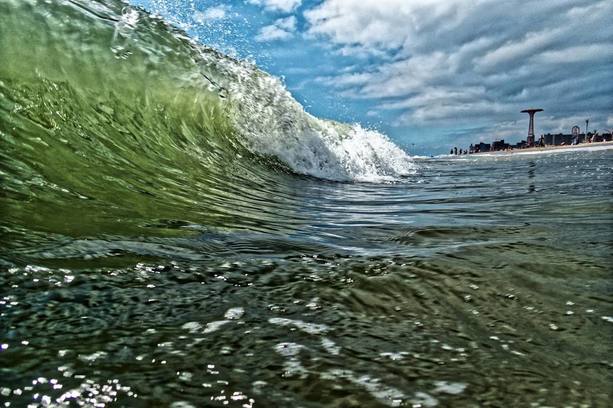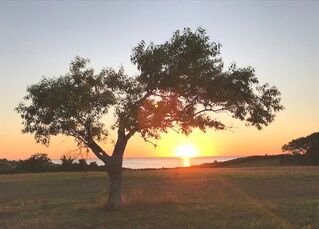 Photo: Jim McDonnell (2018) Photo: Jim McDonnell (2018) Water creates and destroys. It is vital for life, for humans and other animals (we who are mostly water) and for vegetation on which our lives and the lives of almost all other living creatures depend for food and oxygen. It is a source of delight, a tall glass of ice cold water quenching our thirst on a hot day, a cool shower cleansing off the sweat and grit of from a sweltering city day, and a glimpse of a shimmering river, bay or ocean offering a panorama that can fill us with a sense of beauty and awe. Yet, water also annihilates. It turns violent in its machinery of storms, with ravaging hurricanes and wall-of-water tsunamis inundating and destroying homes and possessions and endangering and ending our lives. Over years, water destroys the roofs over our homes. Over eons, it eats away at the land, eroding it to form canyons; as glacial ice, it pushes aside stone, carving grand valleys like giant earth moving equipment. We encounter water-as-destroyer with the arrival of hurricane season, and the 2018 season launched with Florence hitting landfall in the Carolinas this past weekend, swelling rivers, transforming streets into canals, uprooting trees, and destroying homes and lives. Floodwaters continue to rise, with the region’s water supply endangered by contamination from toxic pollutants. Yet, a few hundred miles to the north, with a high pressure system stalling the northward creep of the storm, water was offering its delights to a few dozen swimmers, including myself, participating in an open water event at Coney Island with CIBBOWS, Coney Island Brighton Beach Open Water Swimming, the “Triple Dip”, with options to swim 1, 2, or 3 miles. Despite the devastating conditions in the Carolinas, the conditions at Coney Island were splendid, with air temperature in the mid-seventies and water at a temperature in the low-70s and not unusually turbulent. Swimming at Coney Island offers an experience in contrasts, even separate from markedly different weather systems along the coast. Immersed off the coast in the open water, slicing through modest chop and current, and occasionally bumping into fish, one catches glimpses of the amusement park and its iconic rides: the Cyclone roller coaster, carousel, and Wonder Wheel, looking like giant toys. On the one hand, ocean water, so natural and elemental, and on the other hand, brightly colored attractions built for entertainment. Then again, the water offers its own ride, with wave motion rocking your body and the current redirecting your stroke. But if the amusement park Cyclone was abuzz with activity, so too was a real cyclone, making landfall to the south, and during the day’s swim at Coney Island, the duality of water—like the Hindu god Shiva, destroyer and benefactor—was on many of our minds. After all, it was only 6 years ago that Hurricane Sandy inflicted tens of billions of dollars of devastation in the New York area. Storm surges flooded streets, subways, and tunnels and terminated power for many communities, and we are still experiencing the storm’s effects. The flooded Cortland Street subway station opened just a few weeks ago, and the L train will soon shut down for repairs due to damage incurred from Sandy flooding. Other hurricanes continue to devastate in their aftermath: Maria in Puerto Rico, Harvey in Texas, and Katrina in New Orleans How to reconcile the contrasts in nature? On the one hand, water offered its delights to a group of folks opting for the voluntary adventure of a beach-side open water swim on a sunny day, with a view of a giddy amusement park; yet, a few hundred miles south, water was a force of monstrosity, putting lives at risk. Like the ebb and flow of tides, water gives and takes away. Wind, Water, Stone By Octavio Paz (1979) Translated by Elliot Weinberger Water hollows stone, wind scatters water, stone stops the wind. Water, wind, stone. Wind carves stone, stone's a cup of water, water escapes and is wind. Stone, wind, water. Wind sings in its whirling, water murmurs going by, unmoving stone keeps still. Wind, water, stone. Each is another and no other: crossing and vanishing through their empty names: water, stone, wind.
0 Comments
Seventeen years ago airplanes struck the Twin Towers. Over three thousand lives were lost, including those who perished on the hijacked flight aiming for the Pentagon, with the hearts and minds of thousands of friends and loved ones forever wounded.
In the words of young children, my own included, it was the day “the airplanes flew into the buildings”. If that simple statement elides the tragic loss of lives, it also magnifies the subverted features of a human-created landscape: passenger planes weaponized as bombs, towers so tall that planes could fly into them. We know the tragedy of September 11th was the result of highly coordinated, brutally callous human intention, and in this way the event stands alone. And yet, in exposing how some of our greatest creations can be put to monstrously distorted use, it calls out how contemporary, human-created landscapes can induce a feeling of mortal fear. With depictions of sweeping vistas and craggy mountaintops, landscapes have long been depicted in ways that conjure terror, a concept known as the aesthetic sublime. In the mid-19th Century, John Ruskin lauded the aesthetic sublime of J.M.W. Turner’s paintings and their shift from the purely natural settings and less abstract works of other artists. Turner’s atmospheric skies and industrialized landscapes trending toward abstraction provided a catharsis-inducing experience of viewing the scale and power of nature as well as burgeoning industry. In connection with an exhibit this past spring at New York University’s Grey Art Gallery,“Landscapes After Ruskin: Redefining the Sublime”, artist Chris Wiley in his essay “From the Furious Sea to the Integral Accident” posits the notion of “a new sublime”, a concept of the sublime that has evolved with our relationship to nature in a post-industrialized era. Wiley’s “new sublime” includes nuclear annihilation, catastrophic climate change, out-of-control technological advancement, and terrorism. Notes Wiley, humankind has always encountered threats. In previous eras the threats were from warring tribes, disease, dangerous animals, and naturally-occurring environmental events, such as drought, flooding, earthquakes and volcanoes. In our era, we face existential threats of our own creation. In the words of the philosopher Paul Virilio, describing what he termed “the integral accident”, “When you invent the ship, you also invent the shipwreck; when you invent the plane, you also invent the plane crash…. Every technology carries its own negativity, which is invented at the same time as technological progress.” Nearly two centuries ago it was the scale and power natural landscapes and forces that provoked a sense of the sublime, a sensibility that emerged in tandem with the industrial revolution: as humans exerted greater control over landscape, the fear-inducing aspects of extreme natural settings could be regarded from a growing sense of safety in the surrounding rural landscape. In our Anthropocene Era, landscapes and conditions of our own making conjure a “New Sublime”, or in the words of Joel Sternfeld, photographer and curator of the “Landscapes After Ruskin” exhibit, the “Calamitous Sublime”, and one in which perhaps is not paired with the relative sense of safety in one’s own surroundings. May we have the courage and awareness to recognize how some of our very best creations carry their own negativity, and let us hope we can find ways to manage such risks.  Photo by Nancy Kopans Photo by Nancy Kopans September is here, a time of transitions. Children return to school and, with summer vacations now a pleasant memory, work tends to ramp up. With the days getting shorter many of us turn indoors earlier. We are nearing a time of harvest, and here and there we might notice a leaf’s changed color, a harbinger of the radiance of autumn to come. In the Jewish calendar, a lunar calendar, we are nearing the end of the month of Elul, the days that lead up to the New Year, Rosh Hashanah. Whether or not you are Jewish or religiously-minded, there is something apt about this time of year being the New Year, a time of reflection and a time of a long cycle of new beginnings. A parable teaches that in the month of Elul “God is in the field”. That is, God is not sequestered on the palace throne, surrounded by guards, but rather has ventured into the countryside to meet ordinary people and grant their requests. God is outside and accessible. This time of year thus asks that we be attuned to what is around us and to open our senses to an awareness of a divine presence in nature. It reminds us of the feeling of “what is bigger than ourselves” that we can experience when in nature. Others have noted the sense of the divine in nature. As Thoreau wrote, “Nature is full of genius, full of divinity. (Journal, January 5, 1856). He defined his “profession” as “to be always on the alert to find God in nature—to know his lurking places. To attend all the oratorios—the operas in nature.” (Journal, September 7, 1851). Consider the wisdom of opening one’s senses to the divine in nature, to attend its “oratorios” and “operas” and to be reminded of what is bigger than ourselves. |
About this Blog
Hi! I'm Nancy Kopans, founder of Urban Edge Forest Therapy. Join me on an adventure to discover creative ways to connect with nature in your daily life, ways that are inspired by urban surroundings that can reveal unexpected beauty, with the potential to ignite a sense of wonder. Archives
April 2023
Categories
All
|


 RSS Feed
RSS Feed